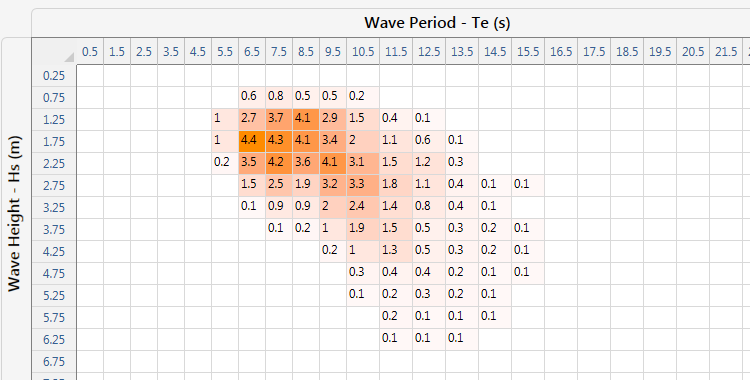Firstly you need to obtain metocean data for your geographical location of interest, and then you may input the relevant scatter diagram information in Flexcom Wave.
•Flexcom Wave interfaces directly with ExceedenceFinance, a third-party software package which contains databases of metocean data for various geographical locations around the world. Provided you have a license for this software, you can quickly download wave resource information for your chosen location, and automatically import this data into Flexcom Wave. Refer to Import from Exceedence for further details. In this case, the Scatter Diagram is automatically populated for you.
•You may have access to existing metocean data from a previous project. If so, simply copy the Environment component from that project into your current project workspace.
•You may have access to an open source or commercial database of metocean data. If this data is available in spreadsheet format, it may be readily copied and pasted directly into the Scatter Diagram. If not, then you will need to manually type in the data.

Scatter Diagram
The software also requires some additional information...
•The wave spectrum type used in the definition of the scatter diagram. The options currently supported are Pierson-Moskowitz and Jonswap.
•Whether your wave periods are defined in terms of Tz or Tp or Te.
Note that the number of occurrences typically represents the number of “three-hour intervals” of that particular combination of Hs and Tz/Tp/Te during a 10 or 20-year period for example. The duration of the period measuring the number of occurrences is in fact immaterial - the specified data is subsequently normalised into percentage occurrence values, so it is only the relative magnitudes which are of importance. If there is no occurrence of a particular combination of Hs and Tz/Tp/Te, you simply leave the corresponding cell blank.
Note that as the latest version of Flexcom predicts an electrical power matrix (e.g. kW), rather than estimating total annual energy production (e.g. MWh), the number of occurrence entries in the scatter diagram are actually immaterial as they are not used by the software.
The simulation of an entire scatter diagram in the time domain can be quite time consuming, so you may wish to explore the possibility of nominating Seastate Blocks and Reference Seastates. This feature allows you to estimate simulation results for seastate combinations which you have not actually simulated, and may be useful during preliminary feasibility studies.